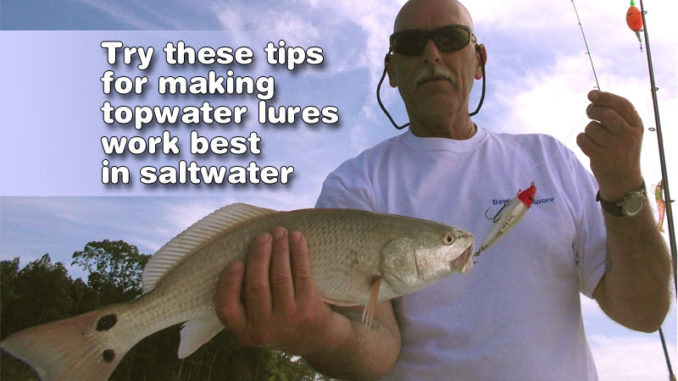
Change size, change hooks, add split rings when the situation requires them
Using topwater lures to catch fish is a favorite technique of many fishermen. The lure wobbles across the surface, imitating a thrashing, wounded baitfish, and the strike comes. And even subtle strikes aren’t subtle. Knowing which baits to choose under different circumstances is a key to success.
“Not everyone can work all topwater lures. And that’s one of the reasons why there are so many sizes and options,” said Capt. Allen Jernigan of Breadman Ventures in Sneads Ferry. “Some lures sit deeper in the water or have a split ring on the nose that requires more effort to get the lure to move. And some lures sit higher on the water and need to be finessed rather than jerked. Still, there are other differences in size and body profile. Many folks think that topwater lures are made in different sizes, with different rattles, to attract different fish. But they also work better in different water conditions.
“I use a lot of Top Dogs, Top Dog Juniors, She Dogs and She Pups,” Jernigan said. “I also use some Zara Spooks and have a Badonk-A-Donk or two in my tackle bag for when the situation requires them. By knowing how each lure works, you can use them to your best advantage, and with modifications as simple as changing the hooks, you can change the way a lure works. Differences between lures – even in the same brand and series – can be size, weight, rattles and materials.
Keep a variety of sizes on hand

Jernigan said size is an obvious difference. And the lure should match the baitfish in the area and the fish being targeted. After size, the most-noticeable differences are the rattles. Baits with higher-frequency rattles attract fish better in windy condition with chop. And baits with lower-frequency rattles generally perform better in calm conditions. Bomber labels Badonk-A-Donks as either high- or low-frequency. MirrOlure makes this difference with Top Dogs and Top Dog Juniors being lower-frequency lures. She Dogs and She Pups are different sizes of their higher-frequency lures.
Lures with a higher-frequency rattle tend to sit higher on the water and will walk with less effort and a more-finessed action, according to Jernigan. Lures with a lower-frequency rattle tend to sit deeper and take more effort and a pronounced pop with the rod tip to make them walk. Jernigan (910-467-1482) said he occasionally has clients that are used to one and can’t easily adjust to the difference. So he switches lures or modifies them to work for that day’s fishermen.
The easiest modifications are changing hooks and split rings or adding a split ring to the lure’s line tie. When he switches hooks, he switches to No. 2 hooks in the Eagle Claw L774BK Series, which are black platinum in color and have a 4X strength rating. They are heavier, cause the lure to sink slightly and tighten up the action while requiring a little more effort to work. Jernigan said to loosen up the action and make the arc of the walk larger, simply add a split ring to the line tie and tie the line to it.




Be the first to comment